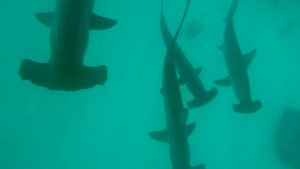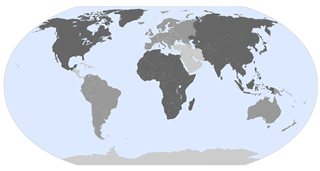Advertisement
Published: July 26th 2017

 Hammerheads
Hammerheads
Courtesy of a fellow diverA friend of mine and her boyfriend recently made up the term "cocktail diving" while in Indonesia. Cocktail diving refers to the kind of diving where you leisurely roll into the dive shop mid-morning, slip into a 3mm shortie wetsuit, dive among colorful fish and coral in clear turquoise 29°C bathtub-like water, before sunning yourself on the boat on the way back to dry land. This is by far the type of diving I enjoy most, and I rarely deviate from it. But I do make a few exceptions, one of which is hammerhead sharks.
The Galápagos are famous for their friendly land-based animals, but among divers they are also famous for one thing in particular: schooling hammerheads. There are only a few places in the world where you can see them and the Galápagos Islands rank high on the list. The primo sites for hammerheads are Isla Wolf and Isla Darwin, located a 20 hour boat ride from the main islands. This means they can only be accessed on a week-long live-aboard cruise. With two young children in tow, this wasn't an option. And of course there's the small issue of having a spare $5000 each on

 Whale shark
Whale shark
Courtesy of Googlehand!
A more realistic option for us was to base ourselves on Santa Cruz Island and take it in turns to do day trips to Gordon Rocks, the next best place to see hammerheads after Wolf and Darwin. I have to admit that I was a bit intimidated by Gordon Rocks' reputation for strong currents and generally advanced conditions. The fact that it is nik-named "The Washing Machine" didn't help calm my nerves! On my first day of diving, the dive-master announced that "we're not diving in the sea now, this is the real ocean." Indeed, it was about as far away from cocktail diving as you can get.
The meeting time for all dives was a bright and early 7am. My 3mm shortie wetsuit was replaced by a cumbersome 7mm long wetsuit. Most importantly of all, there was nothing bathtub-like about the ocean here. It was a chilly 22°C. And I won't even mention the outrageous price (at least compared to Asia). Would the diving here really be worth it?
I'm pleased to say that the answer is a resounding "yes!" We have truly done some of our best dives

 Sea lion
Sea lion
Thanks, Googleever here. I started out by doing Gordon Rocks two days on a run because of Scott's tooth problems. As I back-rolled off the boat into the angry waves for my first dive, and started descending into the depths, the adrenaline definitely started to pump. Within a few minutes, though, I'd settled into the dive and wasn't so afraid. And then there it was: my first hammerhead. It nonchalantly cruised on by with two of its buddies while we divers watched in awe. It clearly understood that it was the boss and we were just strange-looking visitors in its territory.
On each of the four dives I saw hammerheads, sometimes in groups of up to 15, circling around us at times. Add to this a group of graceful eagle rays, many reef sharks, turtles and even a quick appearance by a sea lion and you can see why I braved the cold without question. One very special moment came on my fourth dive at Gordon Rocks when we hit a cold current like a wall of shimmering ice but were treated to an excellent mola-mola sighting. Mola-molas, sometimes called sunfish, are something Scott and I have been
trying to see for years so I was ecstatic to finally see one. They are very large but strange-looking fish, shaped kind of like a disc with fins so small they look quite comical. It was at a cleaning station, an area of the reef where they go to have smaller fish eat off their parasites. It was facing upwards when we came across it in a sort of catatonic state, and I swear it had a smile on its face. We got really close to him, maybe only two meters or less away, and watched him for several seconds before he turned the regular way up and swam off into the blue. I couldn't believe it when we crossed over a rock to find yet another mola-mola in the same position, enjoying his spa treatment. He too watched us as we watched him for about 30 seconds before disappearing into the blue, just like his friend before him.
My next day of diving was at another site called Seymour, dubbed as the second best one after Gordon Rocks. It turned out to be okay, with lots of reef sharks and turtles, but nothing close to Gordon

 Eagle rays
Eagle rays
Nicely done, GoogleRocks. The highlight was when we came across a sea lion sitting on a rock at our level. He looked at us quizzically with his big eyes before swimming off behind the rock and out of sight. The visibility was terrible so it was like diving in pea soup, cold pea soup. I swear a cold current must have come in since the last day of diving I did as I was shivering by only 11 minutes into the dive. By the time we surfaced at 45 minutes, I was told my lips were turning blue. I wasn't so sure about diving the Galápagos again all of a sudden.
This all changed when Scott finally started diving and I heard his stories. We'd heard that the water temperature had dropped and the hammerheads had left, and we got talking to a guy who'd just dived Gordon Rocks and said he'd only seen one hammerhead. This was so different to the dives I'd had, and we were nervous that Scott had blown his chances. When he returned from his first day of diving, I apprehensively asked him how it was and he reported that he'd only seen one

 Hammerhead
Hammerhead
Thanks, Tom, a fellow diverhammerhead. However, I could tell by the huge grin coming across his face that he was trying to fool me. It turned out that he'd had a school of about 18 hammerheads, circling around for a big chunk of the dives. Phew! At least the pressure was off. If he saw no more, at least he could be happy that he'd had two great hammerhead dives.
The next dive he did was again at Gordon Rocks. This time when I bumped into him on the street after the dive, I could tell by the huge grin that he'd had a great day. Not only had there been lots of hammerheads, but a whale shark had come gliding by. Whale sharks are the largest fish in the ocean and are pretty damn cool animals. I guess you never know what can happen at Gordon Rocks!
Excited after hearing Scott's stories, I signed up for another dive day, this time to the island of Floreana to hopefully dive with sea lions. The first dive was nothing special but at least visibility had cleared up and the temperature wasn't quite as cold. The second dive, however, was absolutely one of my best dives ever. I'd signed up specifically to see sea lions, and that's exactly what I got. We jumped in and descended down to about 8 meters and instantly came across a group of four sea lions swimming up and down a channel in the rock wall. Within a few seconds I realized that there were in fact at least 20 seals all swimming around. They'd go to the surface for a gulp of air before diving down right past us like little torpedoes. They were so inquisitive and playful, coming right up to us to check us out. One even bit my fin! There were also a lot of show-offs, blowing bubbles and then chasing them up to the surface or just generally doing acrobatics. We stayed in that exact location for the first 25 minutes of the dive, before moving off to let another diver group move in for their turn. As we swam away along the wall, several sea lions came to swim with us as if asking us to stay and play some more. It really was a magical experience!
Back into the swing of diving again, scott had some great dives on Seymour/Mosquera, with sharks of all types everywhere. Then it was my turn again. Our bank account was draining down fast so this would likely be my last dive day of the trip. I couldn't resist another shot at hammerheads and so chose Gordon Rocks of course. It didn't disappoint! As we were getting ready on the boat, a large group of fish jumped out of the water, quickly followed by a shark fin. At the same time, three shark fins were spotted on the other side of the boat. This was all very promising.
Once we were all squeezed into our thick wetsuits, me with an extra vest layer this time, we descended and started to look out for hammerheads. For the first twenty minutes we saw nothing other than fish in the murky depths and began to worry that the hammerheads had left town. Then suddenly, we saw one. Within seconds, a group of about twenty hammerheads appeared, mothers with babies, and swam below and around us for several minutes before disappearing. Within five minutes we came across another large group of twenty or so. I assumed it was the same group but the dive guide later told us that it was a different group as they were all adults. With about 40 hammerheads in the vicinity, it wasn't surprising that we had hammerheads for most of the rest of the dive and much of the second dive. It was a great way to end, and now I feel like I've really seen the Galápagos. The only problem now is where next? Scott and I are so spoilt that everywhere else will pale in comparison. Now that's what I call a first-world-problem! But there again, a little warm water tropical "cocktail diving" is always nice... the ocean is always beckoning!
Advertisement
Tot: 0.287s; Tpl: 0.012s; cc: 21; qc: 79; dbt: 0.0803s; 1; m:domysql w:travelblog (10.17.0.13); sld: 1;
; mem: 1.2mb













Pankaj Verma
non-member comment
Greats Pics
Nice work Man and great pics